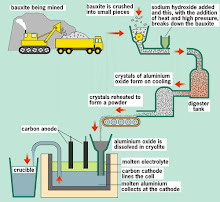Followers
Tuesday, March 9, 2010
carbon compounds....
1. Combustion
2. Substituion reaction
3. Cracking
alkene...
1. Combustion
2. Addition with halogen
3. Hydrogenation
4. Hydration
5. polymerisation
isomerisme...
alcohol...
1. Combustion
2. dehydration
Rate of Reaction
Please come back to this blog and discuss your understanding on this topic...
Wednesday, September 9, 2009
Alloy...
Gold Alloys
| Color of Gold | Alloy Composition |
| Yellow Gold (22K) | Gold 91.67% Silver 5% Copper 2% Zinc 1.33% |
| Red Gold (18K) | Gold 75% Copper 25% |
| Rose Gold (18K) | Gold 75% Copper 22.25% Silver 2.75% |
| Pink Gold (18K) | Gold 75% Copper 20% Silver 5% |
| White Gold (18K) | Gold 75% Platinum or Palladium 25% |
| White Gold (18K) | Gold 75% Palladium 10% Nickel 10% Zinc 5% |
| Gray-White Gold (18K) | Gold 75% Iron 17% Copper 8% |
| Soft Green Gold (18K) | Gold 75% Silver 25% |
| Light Green Gold (18K) | Gold 75% Copper 23% Cadmium 2% |
| Green Gold (18K) | Gold 75% Silver 20% Copper 5% |
| Deep Green Gold (18K) | Gold 75% Silver 15% Copper 6% Cadmium 4% |
| Blue-White or Blue Gold (18K) | Gold 75% Iron 25% |
| Purple Gold | Gold 80% Aluminum 20% |
SALT!!!!!!!

Making Salts: Double Replacement Reactions and Ionic Compounds
In order for a double-replacement reaction to take place, ion has to encounter ion. This typically takes place in solutions. Furthermore, one of the products must be either a molecule, like water, or a gas or an insoluble salt. The following salts, which are found on the back of this sheet, are insoluble. This means that they do not dissolve in water. Your task is to choose to make one of these salts and to separate it in a pure form, using the solubility properties and double replacement reactions. Furthermore, each of the salts has a challenge associated with it. With the help of your instructor your group will choose a salt to make. (Only one group per salt.) A list of starting salts from which you can choose and make your own insoluble salt is at the top of the backside of this sheet. Over the course of the next week you will complete this project and hand in your report as a chemical journal article. (Sample journal articles are available in class for your perusal.)
In your Journal Article you will need to give an account of what you have done. This article will need to contain:
(a) an introductory paragraph in which you lay out your overall purpose, outline a basic procedure, and explain key concepts like a double replacement reaction. Be sure to be specific in your introduction about the salt you are making. Include specific chemical equation(s).
(b) a list your materials and equipment used.
(c) a step by step procedure so that someone else could repeat the lab you did.
(d) recorded measurements and observations. (Be sure to include any measured values, such as masses or volumes or times.)
(e) a explanation of how you met (or tried to meet) the challenge. Put this in a paragraph called “Meeting the Challenge.”
(f) a summary of your overall results within some concluding remarks.
Guidelines for Procedure:
-
Use small amounts of the salts (i.e. <>
-
Be careful not to contaminate the salt supplies; use what you need, put the top back on and return the salt container to the centralized tray.
-
Work in the smaller test tubes so that they will fit into the centrifuge.
-
When using the centrifuge be sure that it is always counterbalanced on the opposite side with a test tube of water of equal volume.
-
Record what you do as you do it. Don’t worry about back tracking and trying again.
-
Dispose of waste solutions and salts in an appropriate waste container as provided.
The next page contains the salts from which you can choose the one you would like. Discuss with your instructor which one would be right for your lab group to choose.
Available Salts:
Sodium carbonate potassium hydroxide cobalt (II) chloride
Zinc sulfate nickel (II) sulfate nickel (II) chloride
Aluminum chloride magnesium sulfate calcium chloride
Copper (II) sulfate copper (II) chloride sodium hydroxide
Magnesium chloride
SALTS TO MAKE – Choose one to make and meet the challenge.
1. Make: Nickel (II) carbonate
Challenge: Take the nickel carbonate, add HCl, interpret results
2. Make: Zinc carbonate
Challenge: After you have the zinc carbonate pure salt, find a way to dissolve it.
3. Make: Cobalt (II) hydroxide
Challenge: Prove to your instructor that all the cobalt ions you started with have been converted to cobalt hydroxide.
4. Make: Aluminum hydroxide
Challenge: Find a way to turn aluminum hydroxide into aluminum nitrate
5. Make: Magnesium carbonate
Challenge: Test pH of all solutions you used. Interpret results.
6. Make: Calcium sulfate
Challenge: End with a blue layer in your test tube
7. Make: Copper (II) hydroxide
Challenge: Gently heat the copper hydroxide using a bunsen burner.
Make a hypothesis as to the identity of the "new" salt formed.









